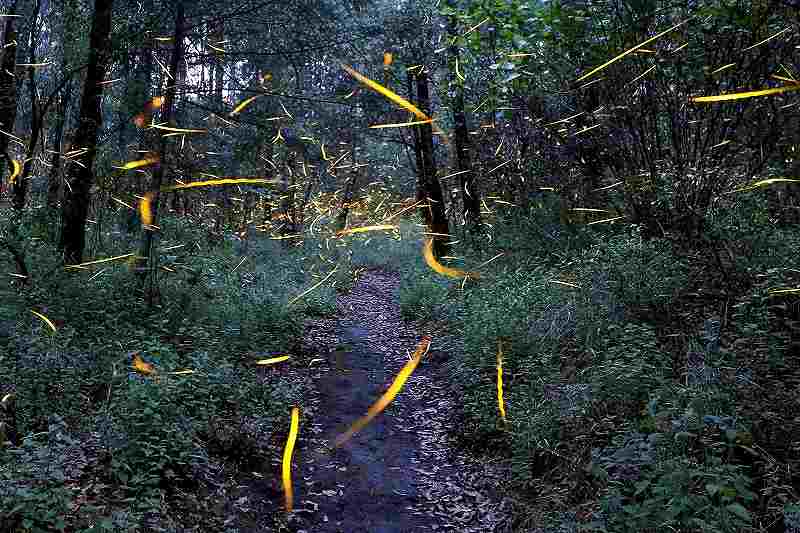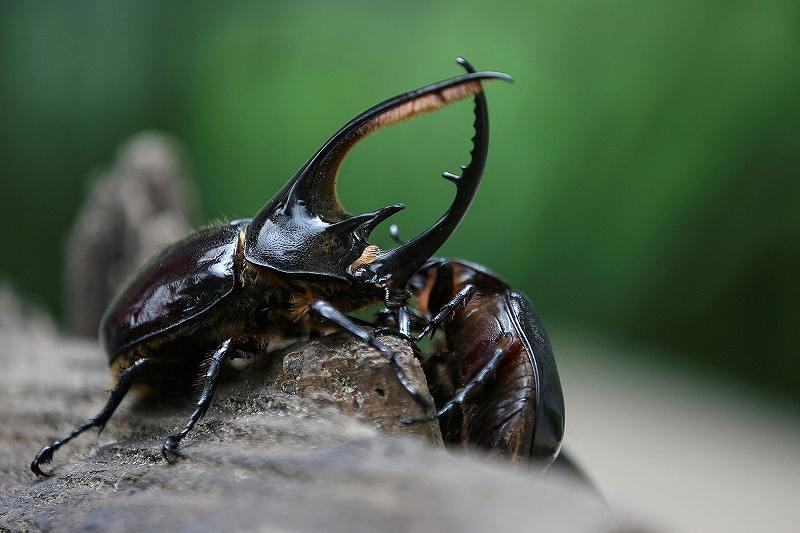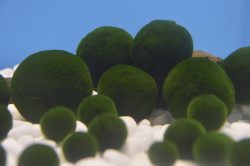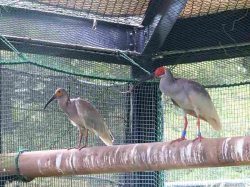
Fireflies seeking mates light up in synchronized bursts inside a forest at Santa Clara sanctuary near the town of Nanacamilpa, Mexico, in July 2017.
14:32 JST, January 5, 2023
As a boy in the 1960s, David Wagner would run around his family’s Missouri farm with a glass jar clutched in his hand, scooping flickering fireflies out of the sky.
“We could fill it up and put it by our bedside at night,” said Wagner, now an entomologist.
That’s all gone, the family farm now paved over with new homes and manicured lawns. And Wagner’s beloved fireflies — like so many insects worldwide — have largely vanished in what scientists are calling the global Insect Apocalypse.
As human activities rapidly transform the planet, the global insect population is declining at an unprecedented rate of up to 2% per year. Amid deforestation, pesticide use, artificial light pollution and climate change, these critters are struggling — along with the crops, flowers and other animals that rely on them to survive.
“Insects are the food that make all the birds and make all the fish,” said Wagner, who works at the University of Connecticut. “They’re the fabric tethering together every freshwater and terrestrial ecosystem across the planet.”
Tree of life
It’s easy to think insects are doing OK. After all, they’re nearly everywhere — crawling through rainforest canopy, burrowing into soil, skimming freshwater ponds or, of course, flitting through the air.
On the biological “tree of life” — which classifies organisms to describe their evolutionary and genetic relationship to one another — insects fall under the branch, or phylum, called Arthropods, one of the 40 branches of the Animal Kingdom.
In terms of diversity, insects are unrivaled, representing two-thirds of the world’s more than 1.5 million documented animal species with millions more bugs likely still undiscovered, scientists said. By comparison, there are roughly 73,000 vertebrates, or animals with a backbone from humans to birds and fish — these represent less than 5% of the known Animal Kingdom, according to the International Union for Conservation of Nature (IUCN).
Their importance to the environment can’t be understated, scientists said. Insects are crucial to the food web, feeding birds, reptiles and mammals such as bats. For some animals, bugs are simply a treat. Plant-eating orangutans delight in slurping up termites from a teeming hill. Humans, too, see some 2,000 species of insects as food.
But insects are so much more than food. Farmers depend on these critters pollinating crops and churning soil to keep it healthy, among other activities.
Insects pollinate more than 75% of global crops, a service valued at up to $577 billion per year, the Intergovernmental Science-Policy Platform on Biodiversity and Ecosystem Services (IPBES) says.
In the United States, insects perform services valued in 2006 at an estimated $57 billion per year, according to a study in the journal BioScience.
Dung beetles alone are worth some $380 million per year to the U.S. cattle industry for their work breaking down manure and churning rangeland soil, the study found.
With fewer insects, “we’d have less food,” said ecologist Dave Goulson at the University of Sussex. “We’d see yields dropping of all of these crops.”
And in nature, about 80% of wild plants rely on insects for pollination. “If insects continue to decline,” Goulson said, “expect some pretty dire consequences for ecosystems generally — and for people.”
Bugs in decline
Describing a stroll through Costa Rica’s Area de Conservacion Guanacaste rainforest, evolutionary ecologist Daniel Janzen in 2019 wrote: “Gone are the spiderwebs that decades back entangled those leaves. Gone is the nighttime sparkle in the leaves reflected from thousands of lycosid spider eyes.”
The world has lost 5% to 10% of all insect species in the last 150 years — or between 250,000 and 500,000 species, according to a February 2020 study in the journal Biological Conservation. Those losses are continuing, though estimates vary due to patchy data as well as uncertainty over how many insects exist.
In the tropics, insects can be “extremely hard to identify, because there are vastly more species than [we] are used to,” Janzen, a University of Pennsylvania professor, told Reuters. “There are more species within 100 kilometers of my dwelling in a national park in northwestern Costa Rica than in all of Europe.”
Not knowing exactly what’s out there makes it harder to detect trouble. One April 2020 analysis in the journal Science suggested the planet is losing about 9% of its land-dwelling insect population each decade. Another January 2021 paper tried to paint a clearer picture by synthesizing more than 80 insect studies and found that insect abundance is declining around 1% to 2% per year. For comparison, the human population is growing at slightly less than 1% per year.
“Even at the low end of 1% a year, after just 40 years you’re down more than one-third of species and one-third of individuals — a third of the entire tree of life lost,” said Wagner, who led the 2021 metastudy, published in the Proceedings of the National Academy of Sciences.
But the reality is likely worse. Wagner’s team offered an “incredibly conservative” loss estimate, he said, noting that many insect studies are conducted in protected areas such as nature reserves. Degraded farmland or cities would likely reveal far fewer insects.
A world of dangers
The demise of insects can’t be attributed to any single cause. Populations are facing simultaneous threats, from habitat loss and industrial farming to climate change. Nitrogen overloading from sewage and fertilizers has turned wetlands into dead zones; artificial light is flooding out nighttime skies; and the growth of urban areas has led to concrete sprawl.
“Until recently, loss of land was the single greatest driver” of the decline, Wagner said. “But climate change is becoming a far more severe and ominous threat by drying out parts of the planet that were chronically wet. And that is absolutely catastrophic for a lot of insects.”
The introduction of non-native plants, which can dominate new environments, has also hurt insects. Because many insects have evolved to feed on or fertilize a single plant species, the disruption of the plant world can have an outsized effect.
For example, the Tegeticula moth species pollinates California’s famed Joshua trees, with the succulent providing the only food source for the moth’s offspring. If Joshua trees were to disappear, so too could the moth. And vice versa.
Winners and losers

Beetles climb a trunk in Tunja, Colombia, in October 2021.
While the situation is bleak for insects at large, a few types of insects are thriving.
“It’s generally the pest insects that are thriving because they’re the ones that breed faster and are favored by human conditions, like all the waste we produce for them to lay their eggs in,” said Sussex’s Goulson.
Climate change is also giving some nuisance species a boost. Rising temperatures are driving major outbreaks of mountain pine bark beetles, which in two decades have decimated roughly 260,000 square kilometers of North American forest. And with warmer, wetter weather, two disease-spreading mosquitoes Aedes aegypti and Aedes albopictus are expected to expand in Asia, North America and Europe, putting an additional 2.3 billion people at risk from dengue fever by 2080, a June 2019 Nature Microbiology study estimated.
Losses beyond insects
As insects go, so go their predators.
In North America, nearly all songbirds feed insects to their young. But since 1970, the number of birds in the United States and Canada has fallen by 29%, or roughly 2.9 billion, which scientists theorize is tied to having fewer insects in the world. Some research also has linked insecticide use with declines in barn swallows, house martins, and swifts.
“Nature is just eroding away very slowly,” Wagner said. As insects disappear, “we’re losing the limbs and the twigs of the tree of life. We’re tearing it apart. And we’re leaving behind a very simplified and ugly tree.”
"Science & Nature" POPULAR ARTICLE
-

Genome Study Reveals Milestone in History of Cat Domestication
-

Big Leap in Quest to Get to Bottom of Climate Ice Mystery
-

Japan Set to Participate in EU’s R&D Framework, Aims to Boost Cooperation in Tech, Energy
-

Paws on Parade: Nairobi’s Dogs Dazzle at ‘Pawchella’
-

Japan’s H3 Rocket Failed in Latest Launch, Says Official
JN ACCESS RANKING
-

Tokyo Economic Security Forum to Hold Inaugural Meeting Amid Tense Global Environment
-

Keidanren Chairman Yoshinobu Tsutsui Visits Kashiwazaki-Kariwa Nuclear Power Plant; Inspects New Emergency Safety System
-

Imports of Rare Earths from China Facing Delays, May Be Caused by Deterioration of Japan-China Relations
-

University of Tokyo Professor Discusses Japanese Economic Security in Interview Ahead of Forum
-

Japan Pulls out of Vietnam Nuclear Project, Complicating Hanoi’s Power Plans
























